By Dan and Lisa Goy from the February 2017 Edition
We started out early from Costa Esmeralda on the Gulf of Mexico Coast following Hwy 180 to Veracruz,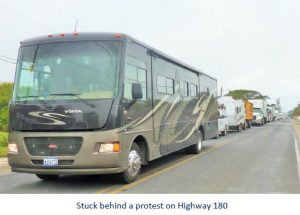 lead by Bruce and Marian. Unfortunately, this was unsuccessful as shortly after our departure we came to halt and a 5-hour lineup because of a blockade. The locals were protesting the state of the road to Tampico.
lead by Bruce and Marian. Unfortunately, this was unsuccessful as shortly after our departure we came to halt and a 5-hour lineup because of a blockade. The locals were protesting the state of the road to Tampico.
We were definitely in solidarity with them as we had recently driven it and can confirm it was in major need of repair. The group took everything in stride. Before you knew it, vendors arrived. We did some shopping in the village of Casitas and Roland entertained some locals roadside.
We met a local performer (they flying around a pole guys) and a young bus driver, Rafael had a good conversation on many Mexican topics. Once the logjam started to move, about 1pm, we returned to Sun Beach Campground to the avoid chaos when the protest was over.
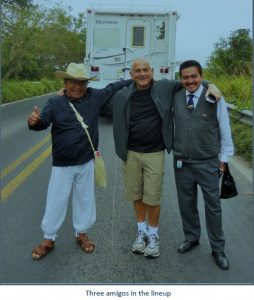 As it turns out, we were now back on schedule and the next day, before 8am, we continued southbound. The road was good to OK from Costa Esmeralda to Boca del Rio (south of Veracruz) where we ended up staying with the RVs. It is always so interesting driving thru villages, where we purchased oranges, crayfish and tamales.
As it turns out, we were now back on schedule and the next day, before 8am, we continued southbound. The road was good to OK from Costa Esmeralda to Boca del Rio (south of Veracruz) where we ended up staying with the RVs. It is always so interesting driving thru villages, where we purchased oranges, crayfish and tamales.
The group found a spot to pull over and I jumped in Rafael and Eileen’s RV to scout out Rancho La Condesa in Church’s book. We decided to stay here at $200 pesos per night, partial services, close to town and well kept grounds on the river with peacocks and iguanas in the trees. After getting settled, we headed out for supplies at Chedraui, next to the Liverpool. What an excellent store and mall!
Mike and Kelly had arranged a group tour in Veracruz the next day. We met at the Hilton in Boca del Rio and piled into 2 vans. We had an extensive tour of Fort San Juan de Ulúa by a very knowledgeable guide, Pablo, that included at stop at the
“El Gran Café de la Parraquoia” for coffee and lunch.
On our return to the campground, Roland gave everyone a lesson on how to prepare and eat crawdads –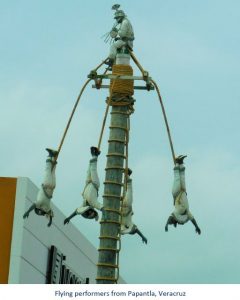 lots of fun and tasty, too! We returned into town on the 3rd day to see more of historic Veracruz and dropped the gang off at the square (Plaza de las Armas), adjacent to the Municipal Palace, Virgen de la Asunción Cathedral.
lots of fun and tasty, too! We returned into town on the 3rd day to see more of historic Veracruz and dropped the gang off at the square (Plaza de las Armas), adjacent to the Municipal Palace, Virgen de la Asunción Cathedral.
Fortunately, I was able to park nearby on the street by using 2 parking meters; 6 pesos for 2 hours, very inexpensive for sure. During our walkabout, Lisa and I were caught on the Google Street View Car, 2nd time for Lisa.
Afterwards, we returned to Rancho La Condesa just after lunch and headed back out in search of fresh potable water. Only a few blocks away, we found a couple of roadside “aqua purificada” stands, 10 pesos for 20 liters, 5 pesos for 10 liters and1 peso for 1 liter. The sun was out, skies were blue and temperatures were rising so many were reading or having a siesta.
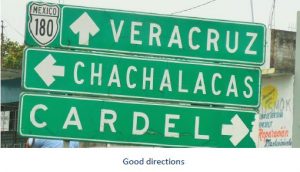 Later some of the group grabbed a cab and headed back into town for dancing in the historic Zócalo. We did enjoy our time in Veracruz, certainly lots to see and do.
Later some of the group grabbed a cab and headed back into town for dancing in the historic Zócalo. We did enjoy our time in Veracruz, certainly lots to see and do.
Some Veracruz History
The Spanish explorer Hernán Cortés arrived in Mexico in 1519 and founded Villa Rica de la Vera Cruz, referring to the area’s gold and dedicated to the “True Cross”, because he landed on the Christian holy day of Good Friday, the day of the Crucifix-ion. It seems all invasions of Mexico from the sea started here. We camped south of the city at Rancho Condesa, an inexpensive scenic spot on the river. Veracruz has much to see including the cultural center of the city, which is its main plaza, officially named Plaza de las Armas but commonly called the Zócalo.
In addition to a couple of visits downtown, we took a guided tour of the Fort San Juan de Ulúa, originally on 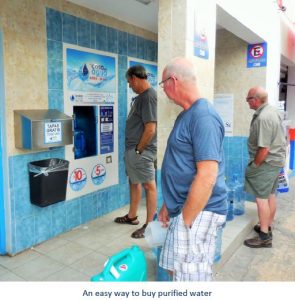 an island which is now connected to land. In the pre-Hispanic era, this island was a sanctuary dedicated to the god Tezcatlipoca. The site where the Spanish first landed has been developed over the centuries and today serves as the container ship terminal of the port. Most of the island is occupied by the fort. This fort was built where the Spanish first landed to conquer Mexico and they used it for their last defense during and just after the Mexican War of Independence.
an island which is now connected to land. In the pre-Hispanic era, this island was a sanctuary dedicated to the god Tezcatlipoca. The site where the Spanish first landed has been developed over the centuries and today serves as the container ship terminal of the port. Most of the island is occupied by the fort. This fort was built where the Spanish first landed to conquer Mexico and they used it for their last defense during and just after the Mexican War of Independence.
Between these periods, the fort helped defend the city against piracy and later was used for prisoners and interrogations of the Mexican Inquisition. Started in 1582 to protect the city from pirates, it was enlarged in 1635 during the period of frequent pirate raids and finally finished in 1707.
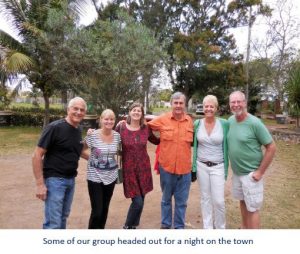 The city was the first on mainland America to receive a European coat of arms, which was authorized by Carlos V in Valladolid, Spain, on 4 July, 1523. The original settlement was moved to what is now known as Antigua, at the mouth of the Huitzilpan (or Antigua River) shortly thereafter. This separated the city from the port, as ships could not enter the shallow river. Ships continued to dock at San Juan de Ulúa, with small boats being used to ferry goods on and off the ships. When large-scale smuggling of goods took place to avoid customs officials, the Spanish Crown ordered the settlement returned to its original site to cut down on that traffic. Docks and an observation tower were constructed on the island to ensure that goods went through customs officials.
The city was the first on mainland America to receive a European coat of arms, which was authorized by Carlos V in Valladolid, Spain, on 4 July, 1523. The original settlement was moved to what is now known as Antigua, at the mouth of the Huitzilpan (or Antigua River) shortly thereafter. This separated the city from the port, as ships could not enter the shallow river. Ships continued to dock at San Juan de Ulúa, with small boats being used to ferry goods on and off the ships. When large-scale smuggling of goods took place to avoid customs officials, the Spanish Crown ordered the settlement returned to its original site to cut down on that traffic. Docks and an observation tower were constructed on the island to ensure that goods went through customs officials.
This city will soon celebrate 500 years of existence, in comparison Canada is celebrating a 150-year 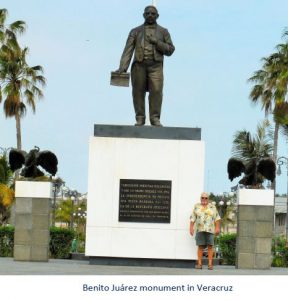 birthday in 2017.
birthday in 2017.
As in other parts of Mexico, the indigenous peoples suffered from epidemics of European infectious diseases and maltreatment, which decimated the population after contact. The Spanish began to import African slaves via the port of Veracruz to work on sugarcane plantations. In the 16th century, this state had more slaves than any other in Mexico. Before the slave trade was abolished, Mexico had the second-highest population of African slaves in the Americas, following Brazil.
By the end of the 16th century, the Spanish had constructed roads to link Veracruz with other cities such as Córdoba, Orizaba, Puebla, Xalapa and Perote. Their gold and silver were the principal exports. This caused the city problems with pi-rates, prompting the construction of Fort San Juan de Ulúa on the island where Grijalva had landed in the mid-16th century. Major public buildings were constructed at the beginning of the 17th century: the municipal palace, the monastery of Nuestra Señora de la Merced, and the Hospital de Nuestra Señora de Loreto.
City of Veracruz and San Juan de Ulúa in 1615 was called ‘City of tables’ because the houses were of wood with flat thatched roofs. In 1618, a fire nearly reduced much of the city to ashes. In 1640, the Barlovento 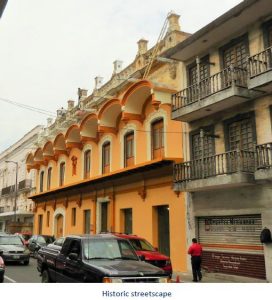 Armada was stationed here for addi-tional defense against pirates. Through the rest of the colonial period, this was the most important port in New Spain, with a large wealthy merchant class that was more prosperous than that of Mexico City. The pirates Van Hoorn, Laurens de Graaf and Michel de Grammont attacked Vera Cruz in 1683.
Armada was stationed here for addi-tional defense against pirates. Through the rest of the colonial period, this was the most important port in New Spain, with a large wealthy merchant class that was more prosperous than that of Mexico City. The pirates Van Hoorn, Laurens de Graaf and Michel de Grammont attacked Vera Cruz in 1683.
The 19th century was marked by armed conflicts. During the Mexican War of Independence, Spain placed troops here to maintain Mexico City’s sea link with Spain. In 1816, Antonio López de Santa Anna commanded royalist troops countering the insurgency. In 1820, insurgents took the city, despite Santa Anna’s attempts to stop them. The last viceroy of New Spain, Juan O’Donojú, arrived here in 1821, where he signed the Treaty of Córdoba with Agustín de Iturbide at Fort San Juan de Ulúa. In 1823, Spanish troops remaining at Fort San Juan de Ulúa fired on the newly-independent Mexican city of Veracruz. The city’s defense against the attack earned its first title of “Heroic City.” During the Pastry War in 1837, the city mounted a defense against a French attack, and earned its second title of “Heroic City.” In 1847 during the Mexican–American War, United States forces invaded the city. It was defended by generals Juan Morales and José Juan de Landero, but they were forced to surrender a few days later. The government of Mexico recog-nized Veracruz with a third title of “Heroic City.” Ten years later, civil war between liberals and conservatives forced Benito Juárez’s government to flee the capital of Mexico City. Juárez went to Veracruz and governed from there in 1857. In 1861 Spain sent its troops to occupy the port in an effort to secure payment of debts, which Juárez had suspended. French military forces accompanied them to prepare for Maximiliano I and occupied the city when the emperor and his wife Carlota of Belgium arrived in 1864.
government of Mexico recog-nized Veracruz with a third title of “Heroic City.” Ten years later, civil war between liberals and conservatives forced Benito Juárez’s government to flee the capital of Mexico City. Juárez went to Veracruz and governed from there in 1857. In 1861 Spain sent its troops to occupy the port in an effort to secure payment of debts, which Juárez had suspended. French military forces accompanied them to prepare for Maximiliano I and occupied the city when the emperor and his wife Carlota of Belgium arrived in 1864.
The conflicts and damaged trade relations with Europe took its toll on the port of Veracruz. By 1902, the port facilities had deteriorated, and it was considered one of the most dangerous on the American coast. President Porfirio Díaz contracted with foreign enterprises to modernize the port’s infrastructure. In 1914, during the Mexican Revolution (1910-1920), the US at-tacked and occupied the port in an effort to try to preserve trade. The city gained its fourth title of “Heroic City”. After the Revolution, most port workers became unionized. Through most of the 20th century, federal and state legal and political initiatives intended to better workers’ lives had effects on the operations of the port. Eventually, unions came to have great power over the operations and tariffs charged. By the latter part of the 20th century, competing unions made the operations of the port difficult. Some blocked access to the port from federal roads and financial corruption was a problem.
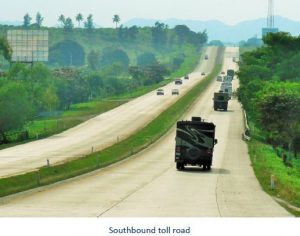 In the 1970s, a federal commission was established to design a new administrative system for the ports of Mexico. The legislature passed laws authorizing the federal government to take control over important ports such as Veracruz. The federal government modernized the port, adopting automation of loading and unloading. This resulted in a reduction of 80% of the port’s jobs and labor resistance through strikes. The dockworkers’ unions unified, negotiating for members to have a stake in a new company to manage the port’s functions, named the Empresa de Servicios Portuarios de Veracruz, S.A. de C.V. The old Compañia Terminal de Veracruz was dissolved in 1988 and the new organization was fully in place by 1991.
In the 1970s, a federal commission was established to design a new administrative system for the ports of Mexico. The legislature passed laws authorizing the federal government to take control over important ports such as Veracruz. The federal government modernized the port, adopting automation of loading and unloading. This resulted in a reduction of 80% of the port’s jobs and labor resistance through strikes. The dockworkers’ unions unified, negotiating for members to have a stake in a new company to manage the port’s functions, named the Empresa de Servicios Portuarios de Veracruz, S.A. de C.V. The old Compañia Terminal de Veracruz was dissolved in 1988 and the new organization was fully in place by 1991.
In September 2010, Hurricane Karl, a small, strong Category 3 hurricane, caused widespread flooding and damage affecting approximately half a million people. Sixteen were confirmed dead with another eleven missing. Sixty-five municipalities in the state were declared disaster areas. Preliminary damage estimates total up to $3.9 billion USD and $50 billion MXN. Much of the most recent commercial development has been in newer areas in the south of the city and in the neighboring municipality of Boca del Río (where we stayed with the RVs), linked by a ten-kilometer road along the shore that caters to tourists and business travelers. The hotels in Veracruz are more rustic and traditional; the modern ones are in Boca del Río, especially near Playa Mocambo. Although Veracruz is not as popular a tourist destination as many other resort areas there are many sites to see. In more recent years, the city has been promoting an identity as a tourist destination, emphasizing new attractions such as the Veracruz Aquarium and the City Museum, and the renovation of historic ones, such as Fort San Juan de Ulúa and the Naval Academy. The Malecón (boardwalk) stretches for kilometers along the Gulf of Mexico, leading from the city center into the suburbs. This area is popular at night, when people stroll and exercise, enjoying the ocean breezes. Near the city center, the Malecón is crowded with merchants selling knick-knacks, souvenirs, jewelry made with seashells, and T-shirts.
Download the full edition or view it online
Dan and Lisa Goy, owners of Baja Amigos RV Caravan Tours, have been making Mexico their second home for more than 30 years and love to introduce Mexico to newcomers.




